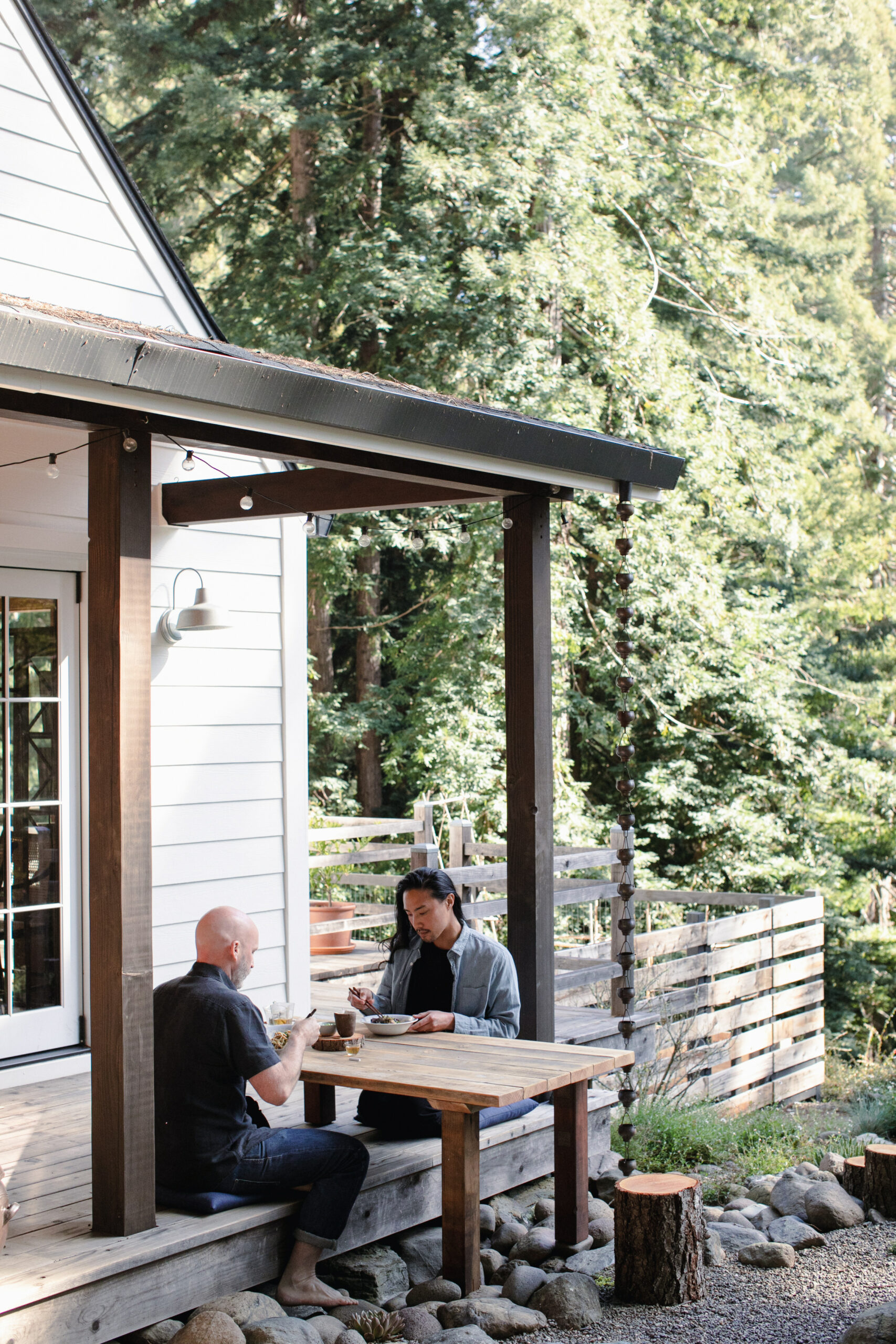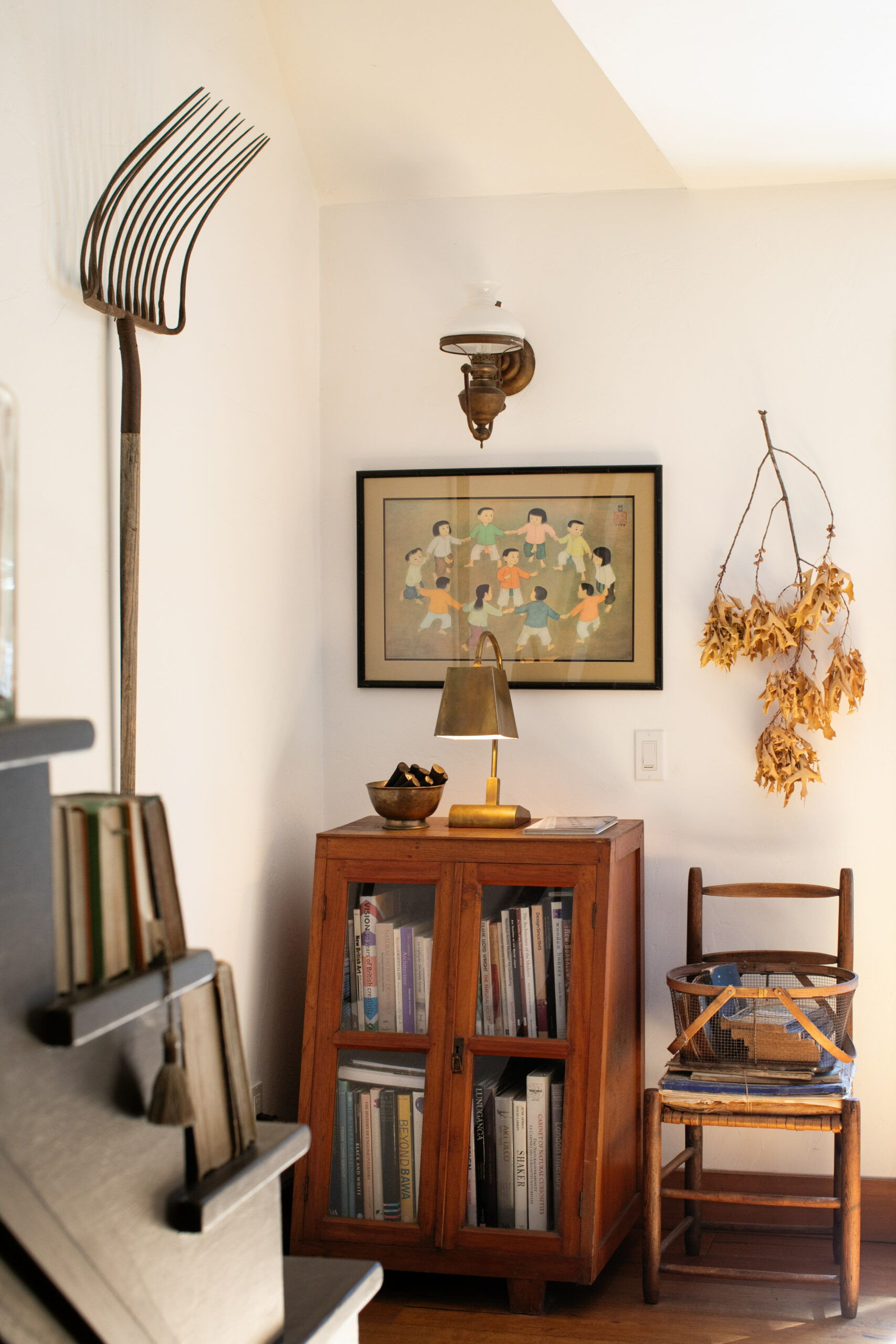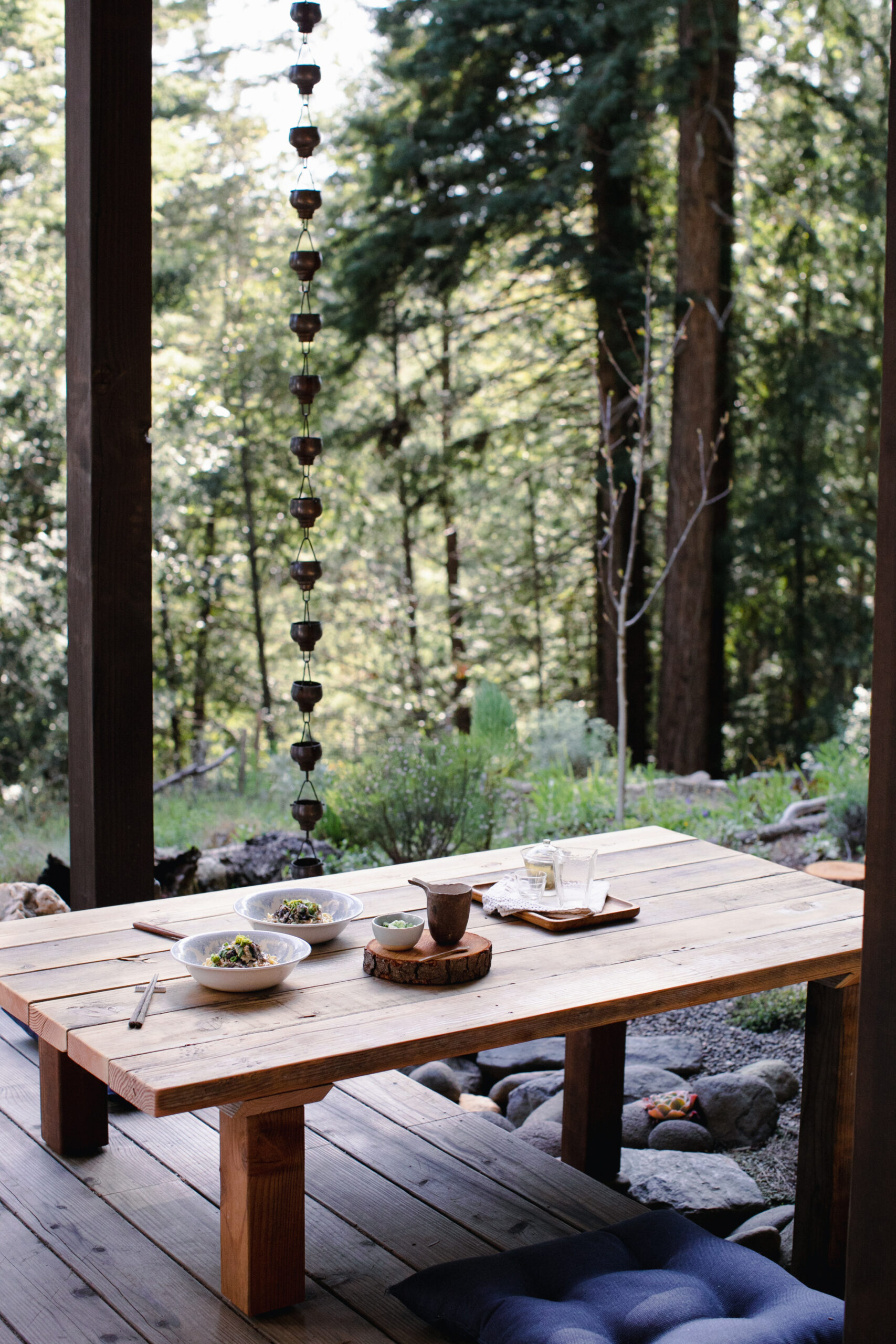Husbands Adrian Chang and Chris Lewis traveled the world together before settling into a cottage in the redwoods outside Occidental. And the roots of the couple’s journey to their home in western Sonoma County are as multilayered and intertwined as those of the surrounding redwoods.
The pair met in Tokyo over a decade ago, where Chang worked in fashion and Lewis was a creative director in the international division of British department store Harrods.
Lewis grew up in both Britain and in the African country of Zambia, where his father worked on a copper mine. Chang was raised in a Chinese American home in the Bay Area and studied textiles and fashion in college before moving to Tokyo to work in design. Together, they’ve traveled constantly, living first in Tokyo, then in Sri Lanka and Singapore before moving to Chang’s native California in 2016, a few months before their wedding.


Long before the trend of the Great Resignation, the couple decided to slow down their lives and move to Sonoma as a way to refocus on shared values of family and home.
“We were living a wonderful life, but it was a life we were becoming increasingly disillusioned with, and we needed to make a change,” explains Lewis.
That change involved not only relocating to Sonoma, but a rededication to the pursuit of craft — for Chang, a focus on traditional Asian cooking, and for Lewis, the chance to return to a love of woodworking and building with salvaged materials.
Over the past six years, the couple has slowly rebuilt their 1,600-square-foot Occidental cottage, with Lewis doing much of the construction himself.
“In our earlier careers, we had spent so much time focusing on other people’s projects, but not getting our hands dirty. So one of our ideas was to find a place which was a real fixer-upper, where I could spend my time applying the trades I’d learned from my father,” explains Lewis. “We really have been swallowed whole by this place in the most wonderful way. And that’s what we wanted, to be fully immersed in it,” adds Chang.


For Lewis, the process of renovating the house has been an opportunity to honor childhood values of making the most of what’s on hand:
“I grew up realizing how resourceful my parents were, living miles and miles away from the nearest town. Everything which my parents had, they had to grow themselves, and my dad would find old things and rebuild them,” Lewis explains.
At the cottage, Lewis’s dedication to process is evident throughout the home — in the re-plastered fireplace, the handcrafted kitchen cabinets, the outdoor tea table and chicken coop, all built with salvaged redwood and fir that Lewis saved from the demolition or collected over time.
“It’s as much recycling as possible — that’s the challenge. How to scrap, how to reuse and make do,” says Lewis.
During the renovations, Lewis did much of the electrical work as well, working with a local electrician who would allow him to observe and work alongside. “I’ve been over every single inch of this place. I know where every spider lives,” Lewis laughs. “But, you know, it’s great to feel that connected to a building. And from a practical point of view, if I hear something, a creak or a buzzing, I know exactly what it is.”

For Chang, the move to the redwoods has been a chance to rediscover his roots in food and forge new connections among the local Asian community.
“Growing up, I was taught to assimilate. That’s what people from immigrant families do, right? But when I moved to Asia, that was the first time I was constantly around people who looked like me.”
The newfound pride in his family background spurred Chang’s desire to absorb as much as possible about traditional Asian ingredients and techniques: working with Asian vegetables, making tofu and soy sauce from scratch, learning to fold dumplings and to make noodles by hand.

Upon returning home to the Bay Area, Chang spent more time with his grandmother, cooking alongside her and observing her ways in the kitchen. He realized that there was an entire community of Asian Americans who longed to create a new relationship with the foods of their roots.
“Food is the best way to do this,” he says. “It is almost a kind of time machine, a portal to reconnecting with parts of who you are.”
In 2018, Chang started an Instagram account to document his experiments and talk about what “real” Chinese and Asian American cooking looks like.
“There was this really great response,” he says happily. “I had a lot of people coming to me and sharing their memories of the same dishes, or sharing their family’s variation on a dish, and connecting over those experiences.”
Chang’s work with traditional foods has led to a career as a food writer and cooking instructor. He started a Bay Area group called the Sticky Rice Supper Club, and a potluck gathering that brings together other Asian Americans and Pacific Islanders and their families to build community around traditional foods.


Since last year, Chang also has been teaching Asian cooking classes online, with guests joining from as far away as Japan and the U.K. to learn, for example, how wild herbs and bitter greens connect with the Chinese seasonal calendar. And under the name Morihouse, he and Lewis are doing occasional food pop-ups in Occidental, serving up their playful approach to foods, such as rice bowls with barbecued pork belly, Japanese potato salad, and Welsh-style purple sauerkraut.
“It’s just this all-encompassing idea of food as community and food as togetherness,” Chang says.
The couple’s home life is marked by a deep connection to place — a world made by hand. It’s evidenced in the food they eat, the tea they brew, the dogs and chickens they’ve made part of their family. “It was the way all of our people used to live — everything was based on the season. It was something to celebrate, whether you lived on a farm and it was harvest time, or whether it was literally what food was available to you,” explains Lewis.
Chang says as the weather warms, their diets shift from the fermented foods they’ve made at home and that have carried them through the winter, to fresher things like green onions and leafy greens grown in their raised beds. They also make and eat a lot of natto, a traditional Japanese soybean dish that is enjoyed in hot weather.
“Now is when we start seeing the fruits of the winter labor — the ferments we made last year are really starting to come into their own. We’ll have finished all of the sauerkraut and kimchi, and we can start eating fresh things from the garden again.”

The couple say they’re surprised by some of the connections they’ve discovered between Lewis’s rural Welsh food culture and Chang’s Chinese roots. The red seaweed gathered along the Sonoma Coast, for example, is a traditional ingredient in both Welsh laverbread, which Lewis’s father grew up eating, and many Asian foods.
“We don’t like the word ‘fusion,’” explains Lewis. “But we end up finding so many similarities in these different traditional foods. We’ll sit here and have something from Adrian’s heritage, something from my own, and the flavors will just blend and work so well together.”
They’re currently working on a cookbook, a reflection of their seasonal approach to eating and living — and perhaps even a small line of textiles and housewares, all connected back to the fundamental values of family and craft.
“It’s really about trying to be a pathway for others to be inspired to explore their own heritage,” says Chang. “When we cook together and talk about our recipes or the things Chris has made, I always say it’s such a great opportunity to make it your own, to use what you have available to you. It’s your taste. Because you’re creating the memories.”

Cold Sesame Noodles with Cucumber and Nori
Serves 2 as a main dish or 4 as a side
This recipe for chilled sesame noodles provides a respite from summertime heat, and is inspired by a classic dish from Szechuan, China, where heritage cook and food writer Adrian Chang’s yeh-yeh (paternal grandfather) was born. Cold ramen noodles are mounded with thin slices of cucumber, nori, and green onions, then served with a creamy sesame dressing.
The nori in this dish is meaningful to both Chang and his husband, Chris Lewis, whose families have deep roots in coastal communities. Chang’s Teochew Chinese and Lewis’s coastal Welsh ancestors were each known for their seaweed seaweed-foraging traditions. Chang explains that red laver, the seaweed known as nori in Japan, grows abundantly along the Sonoma coast. It is light, crunchy, loaded with nutrients, and surprisingly mild in flavor. You can purchase locally -foraged dried nori from Strong Arm Farm in Santa Rosa (strongarmfarm.com) or at local Asian markets. Chang makes ramen noodles by hand, but packaged, dried ramen noodles are widely available in supermarkets.
Chang points out these sesame noodles also pair beautifully with a wide variety of summer vegetables, including halved cherry tomatoes, julienned zucchini, and chopped fresh kale.
For the noodles
• 4 packages dried ramen
• 4 Persian cucumbers, whole, or 1 large cucumber, peeled and seeded
• ½ tsp. sea salt
• 1 cup (about 6 ounces) dried nori, torn into dime-sized pieces
• 2 green onions
• 2 tbsp. roasted sesame seeds
• 2 tbsp. roasted sesame oil, plus more for drizzling
• Zest of 1 yuzu or 1 Meyer lemon
For the sesame dressing
• ½ cup tahini or homemade sesame paste (recipe below)
• ¼ cup soy sauce
• 2 tbsp. rice vinegar
• 2 tsp. sugar
For the sesame paste
• 1 cup roasted sesame seeds
• ¼ cup canola oil
• ¼ cup roasted sesame oil
• 2 tsp. sea salt
Slice cucumbers into thin rounds, then sprinkle with ½ tsp. sea salt. Allow to sweat for 10-15 minutes, then gently squeeze out any water.
Tear or cut nori into small pieces. Soak in cold water until reconstituted, about 10 minutes, then drain. Gently combine the cucumber and nori in a small bowl and set aside.
Boil your noodles until al dente, about 2-4 minutes, depending on the brand. In a colander, rinse under cold water until no longer hot, then drain. Using your hands, gently toss the cooked noodles with a few tablespoons of roasted sesame oil to prevent them from sticking.
If making your own sesame paste, combine the roasted sesame seeds, canola oil, roasted sesame oil, and sea salt in a blender, and blend until smooth.
In a blender, add either tahini or sesame paste to soy sauce, rice vinegar, and sugar, and pulse to combine. The mixture should be the consistency of a creamy salad dressing.
If it’s too thick, add a few teaspoons of water and pulse again. Set aside.
Chop the green onions finely. Reserve a few pinches for topping; toss the remainder with the noodles.
To serve, divide the noodles between two plates and mound the cucumber-nori mixture on top. Spoon the sesame dressing over top, and garnish with chopped green onion, roasted sesame seeds, lemon or yuzu zest, and a drizzle of roasted sesame oil.
For more information on pop-ups and cooking classes, or to read Adrian Chang’s online journal with traditional Chinese recipes and seasonal reflections, visit www.mori.house or find the couple on Instagram @mori.house.





















